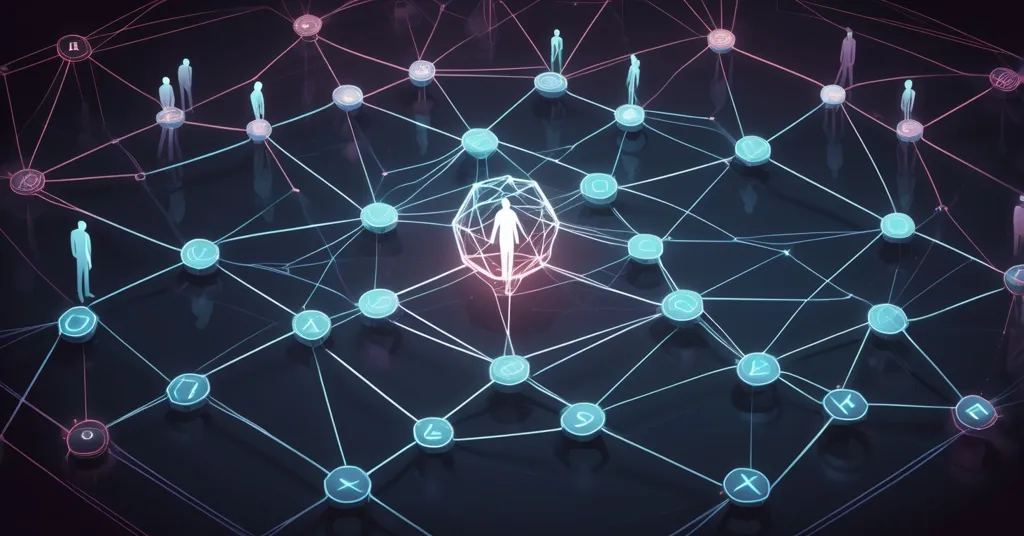Ripple CTO David Schwartz Denies XRP Ledger Manipulation Amid Centralization Fears

Ripple CTO David Schwartz Addresses XRP Ledger Manipulation Rumors Over Unique Node Lists (UNLs)
Ripple pulling the strings of the XRP Ledger? That’s the fear gripping parts of the crypto community, with concerns flaring over the company’s influence on Unique Node Lists (UNLs)—the backbone of XRPL’s consensus system. Ripple CTO David Schwartz has fired back, insisting manipulation is near impossible, but doubts about decentralization persist. Let’s unpack this messy debate that’s got everyone from newbies to OGs scratching their heads.
- Centralization Fears: Ripple’s dominance in publishing UNLs sparks worries over XRP Ledger control.
- CTO’s Rebuttal: Schwartz claims network safeguards prevent manipulation by halting on disagreement.
- Ongoing Skepticism: Despite alternatives, Ripple’s role in XRPL governance remains a hot-button issue.
What Are Unique Node Lists (UNLs)? Breaking Down XRPL’s Core Mechanic
The XRP Ledger (XRPL) isn’t just another blockchain—it’s a speed demon built for fast, dirt-cheap transactions, often outpacing Bitcoin and Ethereum in cross-border payment use cases. Unlike Bitcoin’s energy-hogging proof-of-work or Ethereum’s staking model, XRPL relies on a unique consensus mechanism (the rules a blockchain uses to agree on transactions). At the center of this are Unique Node Lists, or UNLs. Picture UNLs as a VIP guest list at an exclusive club—if a validator isn’t on it, their say on transactions doesn’t count. Nodes, the servers keeping the network alive, use these lists to decide which validators they trust to confirm the ledger’s state. No agreement? The network grinds to a screeching halt, a design meant to block bad actors from sneaking in dodgy transactions.
Here’s the rub: Ripple, the company driving XRPL’s development and tied to the XRP token, publishes most of these UNLs. That’s led to whispers—and outright shouts—that they’ve got too much sway over who gets to be a validator, raising red flags about XRP decentralization. For the uninitiated, validators are entities that verify transactions, and if their selection is skewed toward Ripple-friendly players, the network might not be as distributed as blockchain purists would like. It’s a tension between efficiency and the ethos of trustless systems that’s been haunting XRPL for years.
The Controversy: Ripple’s Control Over XRPL Governance
This latest uproar kicked off when a user on social platforms pointed out a glaring issue: average XRP holders can’t easily switch validators in user-friendly GUI wallets—the slick apps most of us use to manage crypto. Unless you’re tech-savvy enough to run a node and tinker with configuration files, you’re stuck with whatever UNL your node defaults to, often one of Ripple’s. The implication? If Ripple curates most lists, doesn’t that hand them the reins to XRPL governance? It’s a gut-punch question for a space that fetishizes decentralization, where the ideal is no single entity calling the shots.
Let’s back up and add some historical grit to this. Ripple’s dominance over UNLs isn’t new—it’s been baked into XRPL since its early days around 2012. Back then, central coordination made sense to bootstrap a network nobody else was building for. Ripple provided the resources, expertise, and stability to get XRPL off the ground, focusing on use cases like cross-border settlements that Bitcoin couldn’t touch with its sluggish speeds. But as the crypto world evolved, and decentralization became the holy grail, Ripple’s tight grip started smelling fishy to many. Fast forward to now, and with Ripple still curating the majority of UNLs, the community’s unease hasn’t faded—it’s only gotten louder, especially amid the company’s legal brawl with the SEC over whether XRP is a security. If XRP gets slapped with that label, Ripple’s legal obligations could clamp down even harder on XRPL, fanning the flames of centralization fears.
Ripple’s Defense: Schwartz on Manipulation Risks
Enter David Schwartz, Ripple’s CTO and one of XRPL’s original architects, who’s not taking these accusations lying down. Responding to the user’s concerns, he laid out a technical smackdown on why manipulation of the XRP Ledger is a non-starter. According to Schwartz, XRPL is wired with a kill switch: if nodes don’t vibe with the validators on a UNL, the whole network stalls. No consensus, no progress. It’s like a group project where everyone has to agree—or nothing gets done. This built-in protection, he argues, means Ripple can’t just ram through shady validators or transactions without the broader network’s nod. Force it, and you’ve got a brick wall, not a blockchain.
Schwartz’s logic is sound on paper. A halted network benefits no one, least of all Ripple, whose business model leans on XRPL’s reliability for partnerships with banks and payment providers. But critics aren’t buying it wholesale. Sure, the system might prevent outright fraud, but what about subtle influence—say, nudging validator selection toward entities aligned with Ripple’s interests? The stench of centralization wafts around XRPL for many, and they’re not wrong to sniff twice.
Alternatives and Pushback: XRP Ledger Foundation and Community Voices
Schwartz isn’t the only voice in this fight. There’s a glimmer of balance with the XRP Ledger Foundation, an independent body supporting the XRPL ecosystem, which publishes its own UNLs. Node operators—those tech-savvy folks running the servers that power the network—can opt for these lists instead of Ripple’s, theoretically diluting the company’s clout. But here’s the kicker: there’s little transparency on how many operators actually pick the Foundation’s lists over Ripple’s defaults. Without hard stats, it’s tough to gauge if this alternative is a game-changer or just window dressing. That opacity itself is a sore spot for decentralization hawks.
Adding to the chorus, an XRPL validator known as Vet weighed in, clarifying who really holds power. It ain’t the average Joe with XRP in their wallet—it’s the node operators. Much like Bitcoin miners or Ethereum stakers steer their networks, XRPL’s node runners decide which UNLs to follow or even craft their own. Vet’s point is blunt: governance isn’t a democracy for all holders; it’s a technocracy for those maintaining the infrastructure. Harsh as it sounds, that’s standard across blockchains. Still, for casual users locked out of this process, it can feel like watching a boardroom meeting through a one-way mirror.
Community sentiment, especially on platforms like X, isn’t all warm and fuzzy either. Prominent crypto voices, including some Bitcoin maximalists, have called XRPL a “centralized sham,” with posts racking up thousands of likes claiming Ripple’s UNL dominance undermines blockchain’s core promise. Others, more moderate, argue on Reddit threads that Ripple’s role is a necessary evil for now, but urge a roadmap to phase out their influence. This split—between ideological purists and pragmatic defenders—mirrors the broader crypto struggle to balance ideals with reality.
Playing Devil’s Advocate: Centralization or Necessary Stability?
Let’s flip the script for a hot second. Is Ripple the evil overlord some paint it as? Not necessarily. Scaling a blockchain like XRPL takes serious muscle—money, tech know-how, and coordination—that a single company like Ripple can deliver. Their heavy hand in UNLs might just be a pragmatic move to keep the network stable, especially in its formative years when no one else was stepping up. XRPL’s niche in lightning-fast payments, often for institutional use, demands reliability over the wild-west chaos of fully decentralized systems. And with the XRP Ledger Foundation offering alternative lists, there’s at least a stepping stone toward broader distribution of trust.
But here’s the counterpunch: pragmatism doesn’t cut it for those who see blockchain as a middle finger to centralized power. Bitcoin was born to dodge single points of failure—banks, governments, corporations. If XRPL risks letting Ripple control your money’s fate through validator bottlenecks, it’s a betrayal of that vision, no matter how efficient the tech. Even subtle influence over validator diversity (the mix of independent entities validating transactions) can erode censorship resistance and financial sovereignty—values we champion hard. Bitcoin avoids this pitfall with proof-of-work’s raw, messy decentralization, though at the cost of speed. XRPL’s trade-off might suit its niche, but it’s a bitter pill for purists.
Comparing XRPL to Other Blockchains: Where Does It Stand?
To get a fuller picture, let’s stack XRPL’s governance against other heavyweights. Cardano’s staking pools, for instance, spread power across thousands of independent operators, with community-driven delegation cutting down on central choke points—though it’s not perfect, with some pools amassing outsized influence. Solana’s validator clusters lean on high-performance nodes, but critics point to hardware barriers that favor well-funded players, echoing XRPL’s technocratic vibe. Bitcoin, of course, remains the gold standard for many with no central curator like Ripple; miners duke it out in a free-for-all, though mining pools introduce their own centralization headaches.
XRPL’s model, with UNLs as gatekeeper lists, feels more controlled by design—a feature for stability, a bug for trustlessness. Its focus on speed and cost suits specific use cases like remittances, where Bitcoin’s sluggishness or Ethereum’s gas fees flop. But in a head-to-head on decentralization, XRPL often comes up short in the eyes of those who prioritize distributed power over raw performance. It’s less a flaw and more a deliberate choice, but one that keeps the debate raging.
Future Paths: Can XRPL Break Free of Ripple’s Shadow?
So, what’s next for XRPL? Community-driven UNLs could be a start—imagine node operators banding together to curate lists independent of Ripple or even the Foundation. But that takes coordination and tech chops most users don’t have, and there’s no clear data on whether such efforts are gaining steam. Ripple and the Foundation haven’t rolled out a public roadmap to fully cede UNL control, which fuels suspicion they’re comfy with the status quo. Without a transparent push to diversify validator selection, XRPL’s decentralization rap sheet stays tarnished.
One wild card is tech innovation itself. Could XRPL evolve its consensus to lessen reliance on curated lists altogether? Or might node-running tools become user-friendly enough for average holders to jump in? These are long shots, but in a space driven by effective accelerationism—pushing tech forward at breakneck speed—they’re not impossible. For now, the ball’s in Ripple’s court to prove they’re serious about loosening their grip, or risk XRPL being sidelined as a compromised experiment by the broader crypto crowd.
Market Snapshot: XRP Price Amid Governance Noise
While tech debates simmer, XRP’s market performance hums along. Data from CoinMarketCap pegs XRP at around $2.44, up a tidy 3% in the last 24 hours. Does this reflect faith in Schwartz’s assurances, or just broader market tailwinds? Hard to say. Price often dances to its own tune, divorced from governance spats—though a major centralization scandal could tank sentiment fast. For now, investors seem content to HODL while the nerds argue over nodes.
Key Takeaways and Questions on XRP Ledger Governance
- What are Unique Node Lists (UNLs) and their role in the XRP Ledger?
UNLs are curated lists of trusted validators that XRPL nodes rely on to confirm transactions. They’re the gatekeepers of consensus, deciding who gets a say in the network’s state. - Can Ripple manipulate XRPL through its dominance of UNLs?
Ripple CTO David Schwartz says no—XRPL halts if nodes reject validators, blocking forced control. Yet skeptics worry subtle influence over validator picks still gives Ripple too much power. - Who controls XRPL governance—regular holders or node operators?
Node operators hold the keys, choosing UNLs or running custom lists, much like Bitcoin miners. Regular XRP holders are sidelined unless they dive into running nodes themselves. - How decentralized is XRPL with Ripple’s heavy involvement?
Alternatives from the XRP Ledger Foundation offer some balance, but Ripple’s role in most UNLs keeps decentralization a sore spot. True distributed trust remains elusive for many critics. - Why can’t everyday XRP users switch validators easily?
Switching validators means running a node and tweaking configs—a geek-only task not supported in standard GUI wallets. Casual users are effectively locked out of governance. - Why does XRPL’s centralization matter to crypto enthusiasts?
Centralization risks letting one entity dictate your money’s fate, clashing with blockchain’s promise of privacy and censorship resistance. It’s a battle of control versus freedom XRPL can’t escape.
XRPL sits at a jagged crossroads—lauded for speed and utility, yet dogged by questions of trust and power. Schwartz and defenders argue the system’s wired to curb manipulation, but in a crypto world where perception often trumps code, Ripple’s looming shadow keeps nerves on edge. For Bitcoin maximalists, XRPL might never pass muster, but for those open to varied blockchain flavors, it’s a raw case study in trade-offs. One truth cuts through the noise: questioning power in this space isn’t just healthy—it’s damn essential to forging the future we want. Keep pushing, keep doubting, because that’s how we build something unstoppable.



